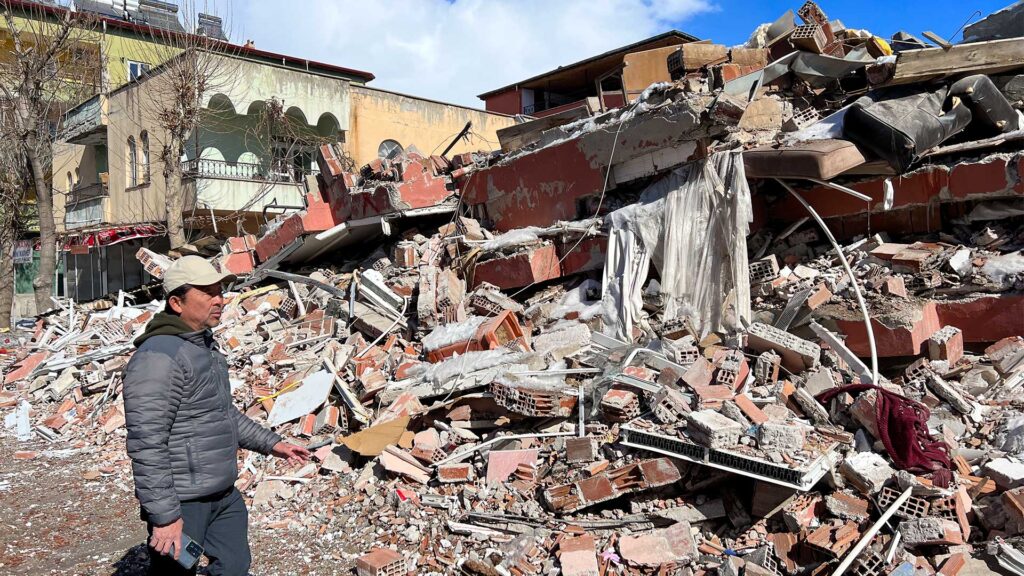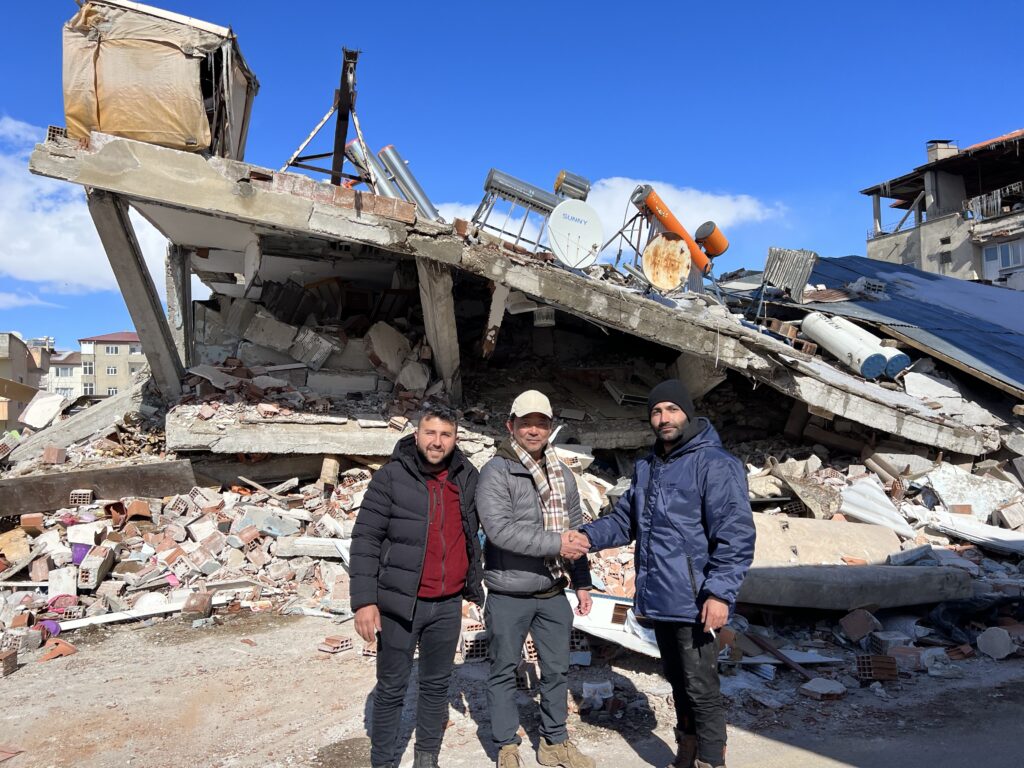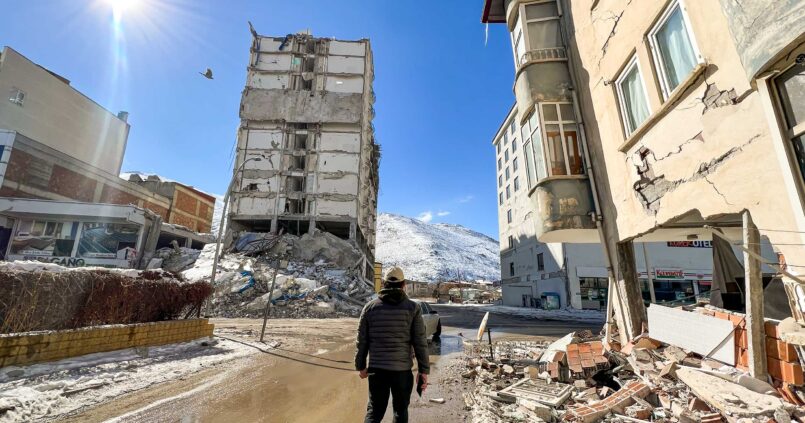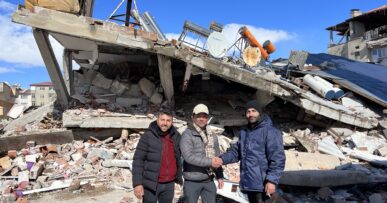By Dr. Kit Miyamoto
I am just now leaving the disaster site on the Syrian border, headed to Istanbul on an 11-hour overnight bus ride. It is rugged. The bus is packed to the brim, above the hubbub is the sound of little kids crying. Those who aren’t, are playing with my laptop, a welcome distraction from the disaster they’ve experienced. They are being evacuated from the general disaster area.
I must say, this disaster in Turkey is one of the worst I have seen in the last 20 years of working in disasters. Yesterday, I was carefully walking through a narrow trail of twisted metal and broken concrete and bricks. In ancient times, this was the old city of Hatay, called Antioch. I would say 90 percent of the buildings there were destroyed. It was a sad scene. I could imagine what the city used to look like—narrow downtown streets full of commerce, packed restaurants, and apartments. These are no more. All disappeared in the early morning tremors of last week.
Why did so many buildings collapse and cause the loss of more than 40,000 lives? The engineering community knew this could happen, and the explanation is simple…
The town is located relatively far from the ruptured fault line, about a couple hundred kilometers away, but it sits on a soft riverbed that cuts through the town. The soft soil in the area had the unfortunate effect of amplifying the motion of the earthquake. Combined with the old building stock, it is a death zone. Thousands of lives were lost here. As I walked along the river, I saw kilometer after kilometer of destroyed or tilted modern mid-rise buildings. The sight reminded me of a picture of Hiroshima after a nuclear blast.
Our team assessed many affected cities last week and formulated recovery strategies based on how the government reacted and the international funds’ strategy. We also met and assisted countless citizens in their broken homes. Many homes are okay. There are pockets of significant destruction, like Hatay, but many areas were spared. This is due to the soil and the geographical effect of the earthquake. The NASA-JPL satellite damage assessment shows that about 20 to 30 percent of building stocks are collapsed or damaged. It is a devastating disaster, but at the same time, many buildings can be salvaged.

We see that there is a need to repair the damaged residential structures. The government has declared that it will reconstruct 30,000 mid-rise apartments, and I am confident they will. Turkey’s construction industry is robust and massive, but a reconstruction of this scale will take some time. It is estimated that 15,000 structures have collapsed. From our past earthquake data, we estimate that an additional 15,000 buildings must be demolished due to extensive damage. That’s a total of 30,000 buildings. In addition, we estimated an additional 100,000 buildings sustained minor damages based on satellite data. Minor damage means one can’t live in that structure unless such damage is repaired. This results in an additional 100,000 apartments that cannot be inhabited. Many former residents either evacuated to different parts of the country, are living in tent cities or, even worse, in their cars. It is estimated that two million people were made homeless instantly.
But why did so many buildings collapse and cause the loss of more than 50,000 lives? The engineering community knew this could happen, and the explanation is simple. The Turkish government changed its building code in the late 1990s by implementing earthquake-resistant designs. Still, anything built before the 2000s was considered dangerous, especially older concrete structures on soft soil, which were death traps, as we saw in Hatay. While these buildings could be retrofitted to be stronger, it takes public support and political will to do so, and such efforts usually only happen after a major disaster.
The most devastating fact is that there is no enforced quality assurance in turkey’s construction industry. There is no licensing for contractors or engineers, which results in anyone being able to become one, including you! Additionally, there is no requirement for quality supervision of construction by engineers. Our team and I went through many collapsed modern construction sites, and while they fared better than older ones, many still collapsed. I didn’t see much evidence of foul play, but the contrary was true for misconstruction.
Small details matter in earthquakes, and there were many critical mis-installations, such as steel hoops in concrete pillars that support the upper floors. If these pillars fail, there will be nothing to protect the inhabitants. Small, rugged rocks in concrete called aggregate are an essential ingredient to bind cement together. However, I saw smooth river pebbles commonly used, which is deadly, as river pebbles cannot bind concrete together under seismic motion. This is a death sentence. These are little things, but they are of great importance when 7.8- and 7.5-magnitude earthquakes happen back to back.
There are news reports of the arrest of engineers and contractors due to fraud, with over 100 already in jail. However, failure analysis is very complex, and it’s difficult to see how anyone can be arrested so quickly. The minimum code worldwide, including in the US, is essentially life safety, which means that the structure will hopefully not collapse, but there’s no guarantee. The minimum code is not good enough for such big earthquakes.
This type of public arrest hype is something I see often in every major disaster, essentially a media show blaming individuals rather than the system itself. It’s a scapegoat effect. Turkish engineers are very good, and the code is modern, but it’s only as good as it is implemented. There will be a significant reform in the licensing system and inspection process, but it is too late for the 40,000 lost lives. Unfortunately, this is always the case, and prevention only happens afterward. In LA, where I live, there are thousands of old concrete constructions similar to those in Turkey. They were built before the mid-1970s when the US code changed. We will see similar issues in LA when a big earthquake hits.

Contrary to media reports, I saw that the government’s response was decisive, quick, and effective in a widespread area. The affected zone is a 300-km-long and 200-km-wide mountainous area, which is not an easy place to access. An agency called AFAD, which is the equivalent to FEMA, spearheaded the effort. They provided 150,000 warm tents in the first few days of the disaster and coordinated a 10,000-member international search and rescue team that saved hundreds of lives. All primary and secondary roads were opened by the end of the first week, and the damaged Hatay airport was opened simultaneously. They even started demolishing dangerously damaged buildings within a few days. I have no idea what the media is talking about, but this is one of the most efficient emergency responses I have ever seen.
Turkey has been preparing for this level of disaster since the deadly 1999 earthquake. I believe if any people could come back stronger from this devastation, it would be the Turkish people. They will rebuild a safer and stronger community fast.


